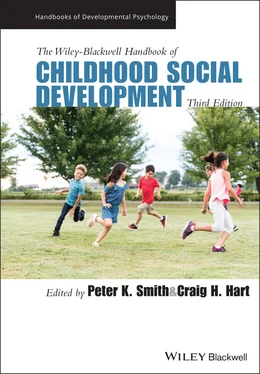In time, some of the assumptions within behavior genetic and child‐by‐environment perspectives (e.g., the primacy of biological influences; a static conception of environments) were criticized because they failed to sufficiently characterize development as an ongoing, dynamic process. For example, it was argued that environments, like their biological or organismic counterparts, should be conceptualized as dynamic rather than static entities – determinants whose influence changed across time in response to children’s growth or maturation (Wachs, 1983).
Criticisms such as these, coupled with the ascendance of dynamic perspectives (e.g., transactional, systems theories; Sameroff & Chandler, 1975; Thelen, 1989) and advances in longitudinal research design and analyses, encouraged scientists to formulate more complex, process‐oriented frameworks. In many instances, these frameworks took the form of multivariate longitudinal process models. Unlike prior perspectives, these models were better suited to theorizing about the dynamic nature of development because they afforded scientists the ability to specify: (a) multiple constructs (i.e., hypothesized causes and consequences); (b) complex patterns of relations among postulated causes and consequences, both concurrently and prospectively (e.g., directions of effect, mediation, moderation, reciprocation of effects, continuities, discontinuities, trajectories, transactions, cascades); and (c) timeframes during which developmental processes (i.e., relations among determinants and outcomes) were postulated to emerge, play out, strengthen or weaken, etc. (e.g., ages, stages, sensitive periods, constant vs. time‐varying intervals, distal vs. proximal lags).
The exact structure of these longitudinal process models often was specific to the facet of social development that was under investigation. However, throughout this era, four overarching classes of multivariate longitudinal process models (i.e., continuity, discontinuity, transactional, and cascade) rose to prominence and played a significant role in theory development and testing.
Continuity models were influential in the formulation and testing of hypotheses about developmental continuities, such as the stability of early‐emerging characteristics (e.g., temperament; specific behavioral dispositions) or the lasting impact of early experiences or relationships (e.g., parent–child attachment). As one illustration, Caspi et al. (1987) postulated that children’s early behavioral dispositions derive from constitutional factors (e.g., temperament) and that, throughout development, these dispositions perpetually orient children toward social contexts (e.g., caregiver, peer relations) that sustain these dispositions via dynamic processes termed interactional and cumulative continuity.
Discontinuity models, in contrast, were formulated to test premises about bio‐organismic and environmental factors that, when activated or experienced, caused shifts (i.e., discontinuities) in previously established developmental trajectories, thereby redirecting children toward more or less adaptive pathways. Frameworks of this type were utilized in research on many aspects of social development. To illustrate, researchers hypothesized that adolescent transitions constituted a “turning point” because the juncture between childhood and adolescence was marked by a confluence of biological, psychological, and social disruptions that altered youths’ previously established adjustment trajectories (Rutter, 1996). Findings consistent with this model’s premises – linking transition‐related disruptions or instabilities with discontinuities in adolescents’ adjustment trajectories – were reported in many investigations (Petersen & Hamburg, 1986).
Transactional models were introduced during the 1970s within the context of infant research (Sameroff & Chandler, 1975) and held, as a principal tenet, that development occurred through a continuous process of dynamic interactions in which infants and caregivers mutually influenced each other (i.e., bidirectional, reciprocal patterns of influence, interdependent effects; Sameroff, 2009). Over time, this conception of development was incorporated into the mainstream of developmental theory and was widely utilized as a framework for research on social development (Sameroff, 2009). In research on marital relations, for example, researchers discovered that parental conflict predicted negative child behavior which, in turn, forecasted higher levels of marital discord (Schermerhorn et al., 2010). Bidirectional or reciprocal patterns of influence also were documented in gene‐environment research, with evidence suggesting that children’s genes shaped their environments which, in turn, influenced their genes (Rutter, 2006).
Cascade models represent a recent innovation in developmental theory. The cascade concept has been defined and applied in various ways in the natural and physical sciences, but in developmental research, it has denoted the process through which different facets of the child’s development (e.g., social, emotional, psychological) mutually or sequentially influence each other to engender diverse developmental outcomes (i.e., broader rather than narrower bands or sequences of effects; spreading, snowballing of consequences; Masten & Cicchetti, 2010). These models principally have been utilized in research on psychopathology and have yielded important discoveries. Findings, for example, have shown that children disposed toward externalizing problems in childhood also were likely to develop academic difficulties, and this combination of problems not only endured but also forecasted the emergence of a third dysfunction later in development (i.e., internalizing problems; Masten et al., 2005). Effects consistent with cascade models also have been reported for children who were exposed to institutional deprivation (Golm et al., 2020) and children who exhibited early‐emerging social difficulties (Van Lier & Koot, 2010).
The emergence of pressing sociocultural issues and public health crises
Many sociocultural issues and public health crises prompted new investigative agendas, instigated conceptual and empirical innovations, and ultimately altered the course of social development research. Because numerous transformative issues and crises occurred, consideration is limited to three prominent exemplars, including research initiatives on childcare, bullying and peer victimization, and ethnic and political violence.
Prompted by changing economic conditions and cultural mores (e.g., increase in dual‐earner families, feminism; Clarke‐Stewart & Parke, 2014), demand for childcare increased during the 1970s and accelerated thereafter. This movement toward nonparental care precipitated concerns, some of which had implications for children’s social development. Foremost among these concerns were questions about whether sustained nonparental care would disrupt parent–child relations (e.g., alter attachment security; Melhuish, 2001), help vs. hinder children’s self‐esteem, and enhance or impair children’s social competence (Phillips et al., 1987).
Accordingly, prominent research objectives included examining the effects of childcare on children’s emotions (e.g., stress), behaviors (e.g., externalizing behavior), and attachments to parents and teachers (McCartney et al., 2010; NICHD Early Child Care Research Network, 2005). Additionally, researchers sought to estimate childcare quality and identify dimensions associated with better‐quality care (Clarke‐Stewart & Allhusen, 2005; Melhuish, 2001).
The research that was undertaken to address these concerns spanned several decades (the 1980s–present) and, at its peak, included large‐scale, long‐term, government‐funded projects such as the NICHD Study for Early Child Care and Youth Development (NICHD Early Child Care Research Network, 2005). These investigations produced an extensive body of evidence that, collectively, characterized childcare as a context that – under certain conditions – could have positive as well as negative effects on children’s social development. Although findings implied that parent–child attachment typically was not altered by children’s participation in childcare, insecure attachments were evidenced when infants experienced both insensitive parenting and sustained poor‐quality childcare (NICHD Early Child Care Research Network, 2005). Time spent in childcare also emerged as a potential risk factor. Evidence indicated that children who attended childcare for longer intervals (i.e., per day, week, yearly, etc.) were more likely to exhibit disruptive, disobedient, and aggressive behavior (McCartney et al., 2010). High‐quality care, in contrast, was linked with many positive dimensions of children’s social development (e.g., sociability, self‐esteem, emotion regulation, prosocial behavior, compliance; Clarke‐Stuart & Allhusen, 2005; NICHD Early Child Care Research Network, 2005) as well as with children’s long‐term social and emotional adjustment (Vandell et al., 2010).
Читать дальше












